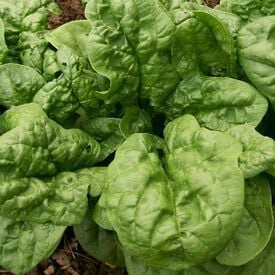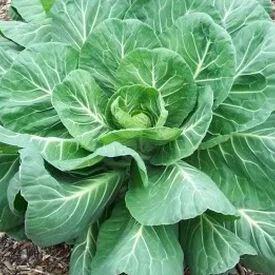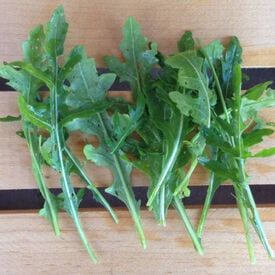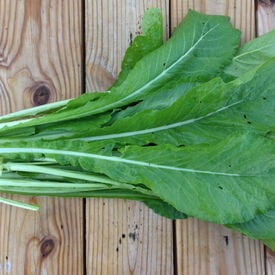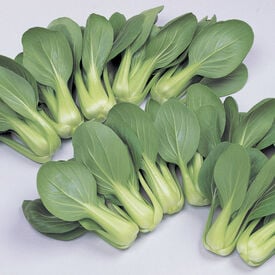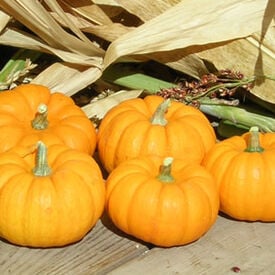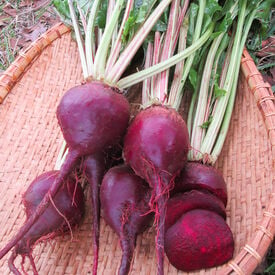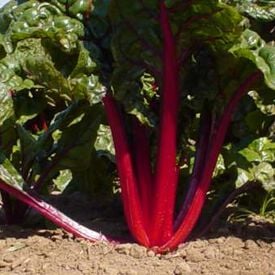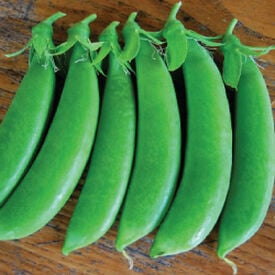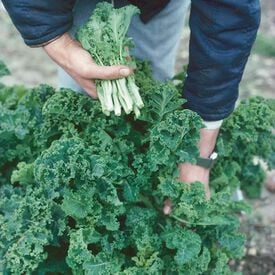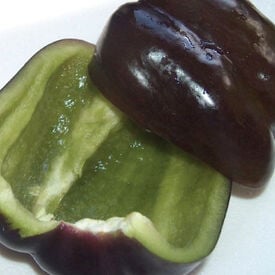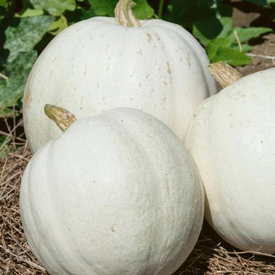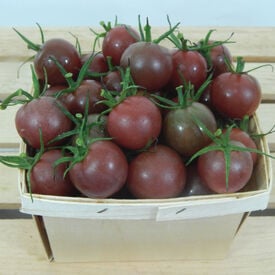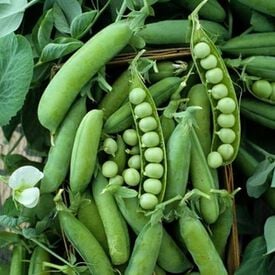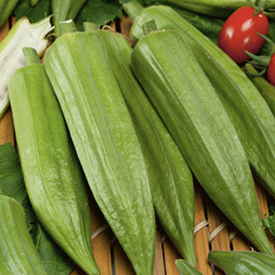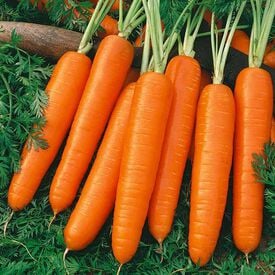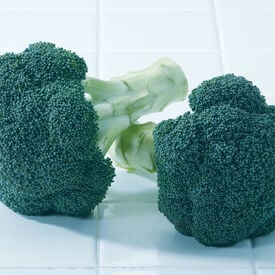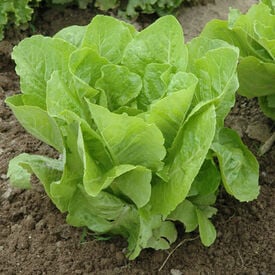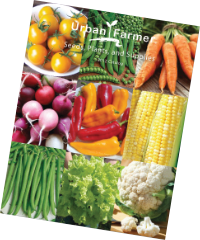The Bloomsdale spinach is such an attractive, tasty, and a popular garden standard spinach. This variety is an old favorite amongst gardeners. It has an excellent flavor and produces large quantities of tasty leaves. Bloomsdale is also very nutritious with lots of Vitamin A, C, and iron and is low in calories.
Georgia Southern is a large collard plant with a cabbage-like taste! This variety produces bluish-green leaves that can grow up to 36" tall and do not bunch or head like cabbage leaves. These large open heads are great for cooking or freezing. The Georgia Southern collard is vitamin rich, sweet, not bitter, heat tolerant, and frost hardy.
A slow growing arugula with great tasting peppery leaves! This variety produces 4" deeply cut leaves that have a slightly sharp pepper flavor. The Sylvetta is compact, heat and cold tolerant. If you are looking to spice up your salads and meals, then this is for you!
Tendergreen Spinach (Komatsuna) mustard is a prized leafy green known for its mild flavor and tender texture, making it a favorite in both culinary and gardening circles. This variety of mustard greens has its roots in traditional Southern U.S. agriculture, where it has been cultivated for its versatility and ease of growth. Characterized by its large, bright green leaves with a smooth, slightly wrinkled texture, Tendergreen mustard is valued for its mild, peppery flavor that becomes more pronounced when cooked. The plants grow rapidly, reaching maturity in about 40 to 50 days, and are known for their robust, upright growth habit, typically standing 12 to 18 inches tall. They produce small, yellow flowers in early spring if allowed to bolt, though they are primarily grown for their leaves. Tendergreen mustard thrives in cool weather and can be grown in a variety of soil types as long as they are well-drained. The plant’s resilience and quick harvest make it ideal for successive plantings, providing a continuous supply of fresh greens. With its rich flavor, adaptable growing conditions, and rapid growth, Tendergreen mustard is a valuable addition to any vegetable garden.
Li Ren Choi cabbage is good looking mini pak choi with light green stems and slightly darker green leaves. This variety develops a pak choi shape at a very early stage. It can even be planted in trays and harvested at transplanting time. It is one of the smaller mini pak choies on the market. Excellent production for pak choi hearts.
The Jack Be Little is a small pumpkin that is popular in many floral arrangements! This new miniature pumpkin is ideal for small Jack'O Lanterns and other decorations. These easy to grow plants bear several small pumpkins per plant. The Jack Be Little pumpkins are edible, but are more highly valued for their decorative value and will last for months if properly cured!
The Lutz Green Leaf White Stem Beet is an attractive deep red variety with white stalks that is absolutely delicious when steamed or roasted. This beet is known for having huge glossy, deep green tops that are perfect for salads! This beet is a "winterkeeper" beet that has a long standing storage capability. The Lutz Green Leaf White Stem has 6 inches in diameter roots.
Ruby Red Swiss Chard is a beautifully deep red colored chard. This variety is great for people who want to grow controlled colors of different Swiss Chard. The Ruby Red is fast growing, very tasty and will add a pop of color to any garden!
The Sugar Snap Pea is a garden staple pea that has unmatchable taste! This variety has tall vines that with support can grow up to 6 feet plus! The Sugar Snap Pea plant produces 3" long pods that are a 1/2" across, and bear over a long picking period. This is pea is so tasty that people will eat it directly after picking! Sugar Snap yields well in both hot and cold weather.
The White Russian Kale is a delicious dark green oak leaf cut kale with white stems that is amazing when cooked or eaten raw. This variety has a crisp sweet flavor that only intensifies when it is cooked. This popular kale is also disease resistant.
The Purple Beauty Pepper is a productive pepper plant that produces attractive deep purple colored peppers! This pepper is an open-pollinated variety with a sweet tasting 3x3" block shaped peppers. Pick when the pepper is purple or wait for it to turn deep red when its mature, which happens later in the season. The Purple Beauty is a great pepper for container gardening and can add that extra kick to your salads or meals.
The Casper Pumpkin is a white skinned ornamental pumpkin with a thick orange flesh that is of excellent eating quality. This variety grows to be 9-12 inches in diameter and 10-16 pounds. Casper's handle is tan with a corky texture and its skin has less bluing than many other white varieties.
Black Cherry tomatoes are a sought-after heirloom variety known for their distinctive appearance and exceptional taste. Originating from a blend of traditional cherry tomato varieties, this cultivar has become popular for its rich, dark color and robust flavor. The tomatoes are small, typically about the size of a marble, with a deep, dusky purple to black hue that turns almost mahogany when fully ripe. Their flavor is renowned for its sweet, complex taste with subtle hints of smokiness, making them a delightful addition to salads, snacking, and gourmet dishes. Black Cherry tomatoes usually reach maturity in about 60 to 70 days, making them one of the quicker-maturing cherry varieties. The plants exhibit an indeterminate growth habit, producing fruit continuously throughout the growing season and requiring staking or caging to support their vigorous, sprawling vines. With their attractive color, rich flavor, and prolific yield, Black Cherry tomatoes are a favorite among gardeners and culinary enthusiasts seeking both beauty and taste.
Alaska pea seeds grow into one of the oldest and earliest-maturing pea varieties, first introduced in the late 1800s and valued for its ability to thrive in cool northern climates. This hardy shelling pea produces compact, vining plants that yield an abundance of small, smooth, bright green pods filled with sweet, tender peas in just about 55 days, making it a favorite for short-season gardeners. The plants are relatively easy to grow, preferring well-drained soil and cool weather, and they often set pods before summer heat diminishes yields. With a mild, slightly starchy sweetness, Alaska peas are excellent for fresh eating, freezing, or canning, and have long been popular in soups and stews due to their ability to hold flavor and texture after cooking. Their dependable growth and versatile use have kept them a staple in gardens for well over a century.
Organic - The Star of David is an Israeli okra variety with grooves, making it resemble a "star." This okra's unbranched stalks grow 8-10 ft. and produce 7" long pods with medium spines if left to mature. Star of David is a bright green okra with purple coloration on top of leaf petioles and major leaf veins. This variety is best picked when small and will keep well. Conventional seed available.
The fine smooth texture of the Nantes carrot makes it perfect for fresh eating, freezing or juicing! This bright orange carrot is a garden favorite. Nantes has an excellent sweet flavor as an early baby carrot. It can be over-wintered or grown in high tunnels for a spring harvest. Certified Organic. Learn more about our organic seeds.
Green Magic is a great summer and fall broccoli that is consistent performer. This broccoli matures mid-early and has wide adaptability to gardening zones. It has a semi-domed, tight head with medium-small bead size and a good plant habit.
The Jericho Lettuce is known for its great baby leaf production and is very tolerant to hot weather. This lettuce is a blonde romaine that can be grown for both baby leaf and full-size heads. This lettuce variety is very attractive with its bright light-green leaves. Jericho is tolerant to both heat and tipburn. Certified Organic. Learn more about our organic seeds.
